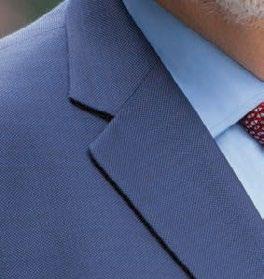
2 minute read
5 Tips to Get Your Lawyer Biography Noticed
by Lance Godard
so, keep it in. If not, consider highlighting it elsewhere, like in a representation list or with a practice group designation.
Ask yourself if this skill or that experience is relevant to the audience you’re trying to reach.
Of course, there’s no ‘right length’ for bios, particularly since they must complement your firm’s style and conventions and align with the time you’ve been practicing. Still, my rule of thumb is typically between 250 and 350 words for senior associates and junior and mid-level partners. First-year associate bios will be shorter, in the 100-150 word range, and those for senior partners and firm leadership can easily approach 500 words.
Use Plain English Nobody likes legalese. Not other lawyers, not CEOs and business managers, not even your mother. (Really. Just ask her.) And certainly no one wants to dig through legalese in a lawyer biography.
Use plain English phrasings to make your bio easy—and enjoyable—to read. Avoid overly technical descriptions of client problems you’ve solved, lawsuits you’ve argued, and negotiations you’ve handled. Simple and relatable language that everyone understands will make your talents stand out so that readers won’t be left scratching their heads wondering what you actually do.
Don’t Hide Your Personality Remember the proverb “all work and no play makes Jack a dull boy”? Turns out it’s true for lawyers, too. Describing your activities outside the office gives readers the complete picture of who you are, what you care about, and how you spend your time. Extracurricular activities—professional and personal—can also be a great conversation starter.
Law is a relationship business, and those relationships are often boosted by affinities you share with peers and prospects.
Clients want to hire real people to do their work, people with personalities and interests that go beyond their practice. Whether you’re president of an industry trade association, a long-time runner who’s completed marathons in 25 states, or a volunteer at the local food bank, talk about it in a sentence or two at the end of your bio to illustrate what you do when you’re not working. Your bio should tell your story, what you’re good at, and why clients should hire you. Now get writing. n
Lance Godard has helped lawyers and law firms articulate their value, engage their readers, and grow their business through compelling content for three decades. Follow his work on www.linkedin.com/in/lancegodard.























At trial, capturing juror attention and sentiment is the primary objective. During every stage of the trial, with every witness, with every document, every demonstrative, and with every bullet point on every PowerPoint slide, attorneys constantly ask one critical question: “How will the jury look at this?”
Of course, there is no way to know how jurors feel while the trial is going on. Judges admonish everyone involved in the trial to refrain from even saying “Good morning” as they ride up to the courtroom in the elevator. In many jurisdictions, courts might allow the lawyers to question jurors after a verdict, which might be useful in serial litigation or just for general edification but is not much help in the case at hand.
One alternative to keeping track of juror sentiment during a trial is to utilize a shadow jury.

Traditional Shadow Juries vs. Remote
In the traditional shadow jury, litigation, or trial, consultants select a small sample of surrogate jurors to resemble the actual seated jurors. Here’s a brief overview of how a shadow jury would work in a typical sense.
• The shadow jurors, affectionately known as “shadows,” meet with the litigation consultants every day before and after court.
• Then, all day, every day of the trial, one or two consultant-shepherds lead the shadow jurors in and out of the courtroom, in sync with the real jurors’ entries and exits. (It is not at all unusual for a third of the total trial time to be devoted to arguments out of the presence of the jury).
• While the real jurors wait in their room, the shadow jurors bide their time in the hallway. At the end of every day, the litigation consultants administer a quick questionnaire or perhaps debrief the shadows individually.







